Two students P and Q perform an experiment to verify Ohm’s law for a conductor with resistance R. They use a current source and a voltmeter with least counts of mA and mV, respectively. The plots of the variation of voltage drop (V) across R with current (I) for both are shown below
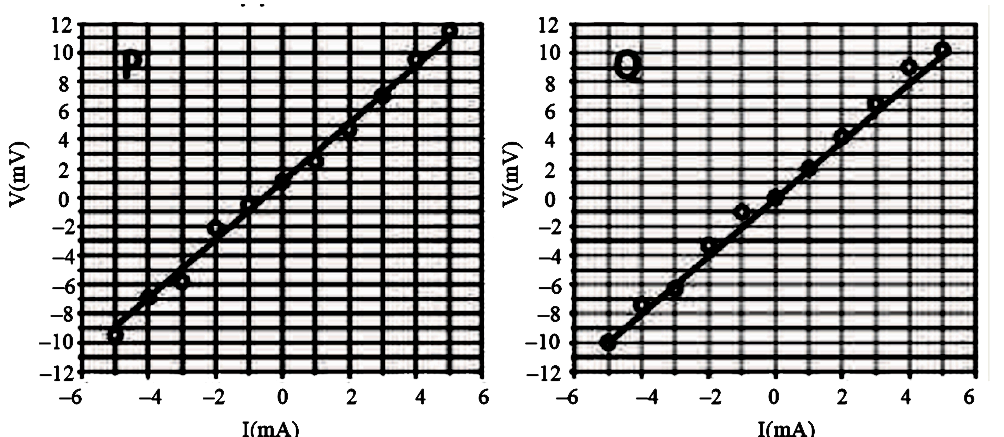
The statement which is most likely to be correct is:
P has only random error (s).
Q has only systematic error (s).
Q has both random and systematic errors.
P has both random and systematic errors.
The correct Answer is:D
Step by step video, text & image solution for Two students P and Q perform an experiment to verify Ohm’s law for a conductor with resistance R. They use a current source and a voltmeter with least counts of 0.1 mA and 0.1 mV, respectively. The plots of the variation of voltage drop (V) across R with current (I) for both are shown below The statement which is most likely to be correct is: by Physics experts to help you in doubts & scoring excellent marks in Class 12 exams.
Topper's Solved these Questions
Similar Questions
A wide bottom cylindrical massless plastic container of height 9 cm has 40 identical coins inside it and is floating on water with 3 cm inside the water. If we start putting more of such coins on its lid. It is observed that after N coins are put, its equilibrium changes from stable to unstable. Equilibrium in floating is stable if the geometric center of the submerged portion is above the center of mass of the object) The value of N is closed to
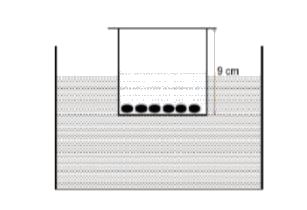 02:36View Solution
02:36View SolutionTo verify Ohm's law, a student connects the voltmeter across the battery as shown in the figure. The measure voltage is plotted as a function of the current, and the following graph is obtained


if VO is almost zero. identify the correct statement02:21View SolutionAssertion(A): In Ohm's law experiment potential drop across a resistance wire was measured as 5.0V and current was measured as 2.00A . The maximum permissible error in resistance is +-25% Reason(R ): In experiment of assertion the least count of ammeter is 0.01A .
02:31View SolutionIn the, Ohm's law experiment ot find resistance of unknown resistor R, the arrangement is as shown. The resistance measured is given by R_("measured")=(V)/(i)V= voltage reading of voltmeter. i=current reading of ammeter. The ammeters and the voltmeter used are not ideal, and have resistance R_(A) and R_(V) respectively. For arrangement shown, the meausred resistance is
03:26View SolutionIn the circuit shown below, a student performing Ohm’s law experiment accidently puts the voltmeter and the ammeter as shown in the circuit below, the reading in the voltmeter will be close to
01:22View SolutionIn ohm's law experiment potential drop across a resistance was measured as v = 5.0 volt and current was measured as I = 2.0amp If least count of the volmeter and ammeter are 0.1V and 0.01A respectively then find the maximum permissible error in resistance .
03:09View SolutionThe graph of current versus voltage drop across the three resistors P,Q,R is shown above. Find the ratio of their resistances.
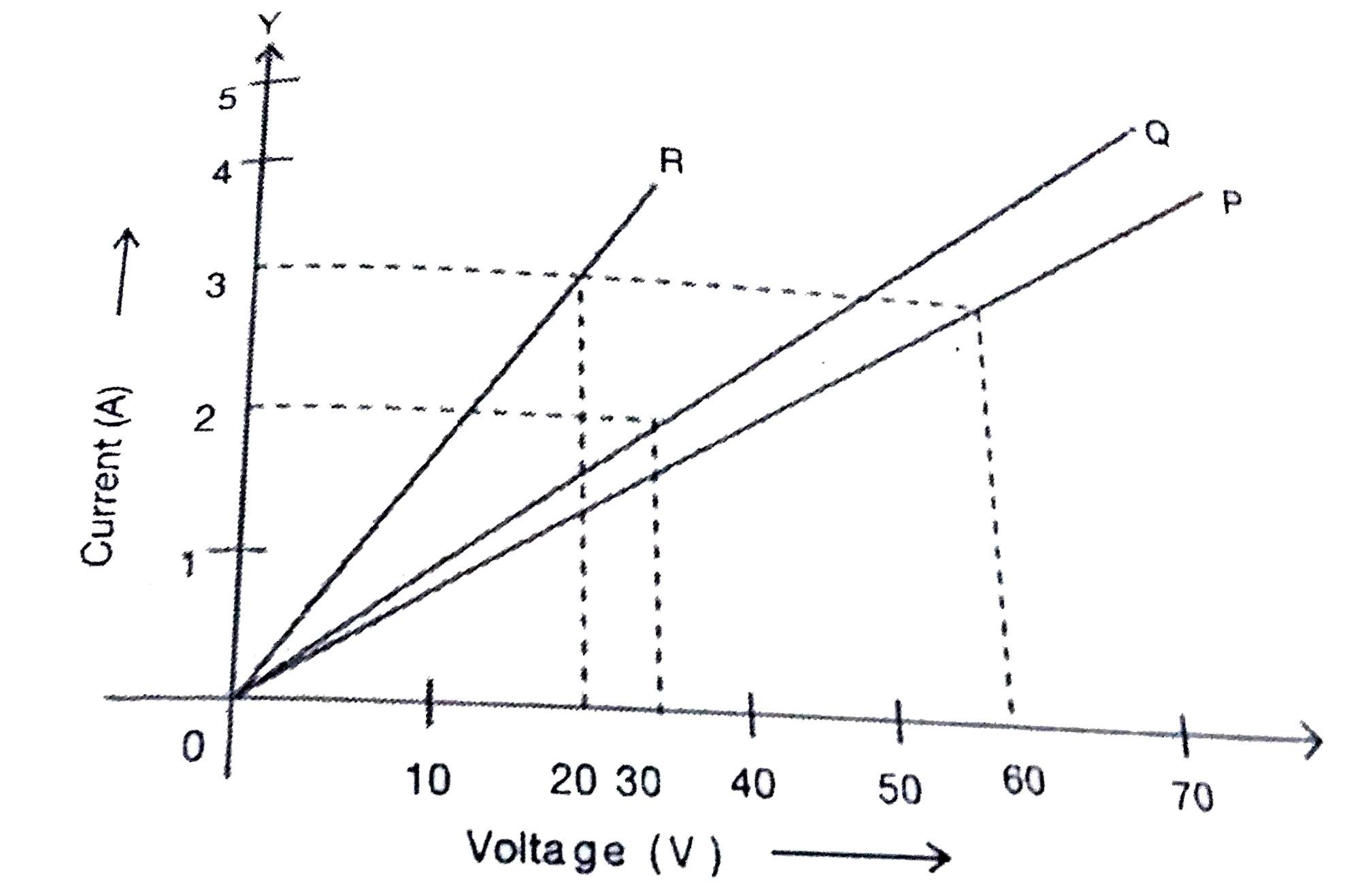 04:04View Solution
04:04View SolutionA voltmeter has a least count of 0.1 V and an ammeter has a least count of 0.1 A. The potential drop V across a resistance is measured as 10.0 V and current through it is measured as 1.0 A .Select the correct alternative
03:40View SolutionIn the circuit given below , V(t) is the sinusoidal voltage source , voltage drop VAB(t) across the resistance R is
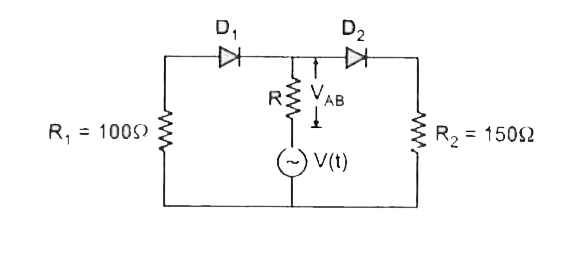 03:05View Solution
03:05View SolutionTo verify Ohm's law, a student connects the voltmeter across the battery as shown in the figure. The measure voltage is plotted as a function of the current, and the following graph is obtained


if VO is almost zero. identify the correct statement03:59View SolutionA resistance R is connected to a cell of EMF E and has an internal resistance r as shown in the figure. The voltage across R is measured using and ideal A voltmeter and circuit current is measured by an ammeter. A rheostat of negligible resistance is used to vary the current in the circuit.

-Write down the expression for current in the circuit and voltage across R at any instant.03:11View SolutionThe resistance R of a metallic conductor is equal to the ratio of potential difference V across the resistor to the current I through the conductor. Calculate R given tat V=(11.1±0.1) volt and I=(5.5±0.5)A
02:21View SolutionIn the circuit given below, V(t) is the sinusoidal voltage source, voltage drop VAB(t) across the resistance R is
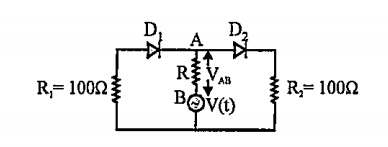 05:14View Solution
05:14View SolutionA voltmeter has a least count of 0.1 V and an ammeter has a least count of 0.1 A. The potential drop V across a resistance is measured as 10.0 V and current through it is measured as 1.0 A .Select the correct alternative
01:18View SolutionIn ohm's law experiment potential drop across a resistance was measured as v = 5.0 volt and current was measured as I = 2.0amp If least count of the volmeter and ammeter are 0.1V and 0.01A respectively then find the maximum permissible error in resistance .
02:42View Solution

